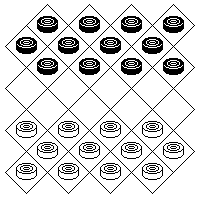
In the 19th century, a number of inventors proposed improved versions of the checkerboard with only the 32 squares actually used to play the game.
I remember having read of a form of checkers traditionally played in one country on a board such as the one illustrated here; it may have been the game of Dama, as played in the Philippines, although a current web search seems to indicate that it is at least most commonly played on the conventional board at this time.
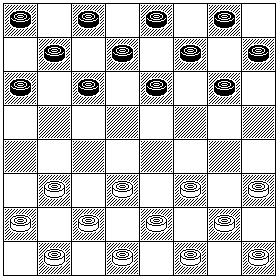
Several alternate sets of rules for Checkers were used in different European countries. In each case, the board was reversed (achievable by changing its orientation by 90 degrees) from that of the chessboard.
In Russian Checkers, kings can make jumps to any square along a diagonal which contains only one opposing piece which is captured, so the opposing piece does not need to be adjacent to the king, and the ending square of the move does not need to be adjacent to the piece captured. A man cannot capture a king. Men can capture backwards as well as forwards, although they can only move forwards without capturing. A capturing move that causes a man to reach the last row results in the man promoting to a king immediately, and then continuing its move as a king.
In Italian Checkers, a player not only must capture when possible, but must take as many pieces as possible, and furthermore, must take kings rather than men when there is a choice of different captures of equal number of pieces. However, a man cannot capture a king.
Spanish Checkers is played as Italian Checkers, but adds the rule that kings can make jumps to any square along a diagonal which contains only one opposing piece which is captured, so the opposing piece does not need to be adjacent to the king, and the ending square of the move does not need to be adjacent to the piece captured.
German Checkers is played as Spanish Checkers, but while men can still only move forwards, they can jump backwards as well as forwards, and they do not promote if they reach the last row of the board during a capturing move if that move can, and therfore must, continue with further jumps away from the last row. Unless, of course, they reach the last row again in that same move with no continuation away.
German Checkers is now also known as Brazilian Checkers, since it is still played in Brazil, while International Checkers is more commonly played in Germany at the present time.
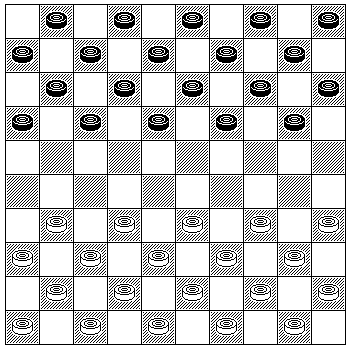
Polish Checkers, which is also known as Continental Checkers, and more recently also as International Checkers, is the most common form of the game played internationally, and is played on a 10 by 10 board, otherwise following the rules of German Checkers. No two-move or three-move restriction has been adopted for the serious play of this form of the game, it appears, since there is no mention of such a restriction in the official rules for the game on the web site of the Fédération Mondiale du Jeu de Dames.
(Which web site refers to FMJD as standing for "World Draughts Federation", and is, as far as I can tell, in English only. There is certainly precedent for giving the names of organizations in more than one language; thus, FIDE (Fédération Internationale Des Échecs) is sometimes referred to as the World Chess Federation, and CERN (Centre Européen pour la Recherche Nucléaire) as the European Organization for Nuclear Research [actually, even in the French name, it has now been changed from a center to an organization, so the abbreviation is still CERN, but the French name is now Organisation Européenne pour la Recherche Nucléaire. (!) But the name change itself, no doubt, was done simply to reflect that they now have more than one facility for nuclear physicists], but being left to guess at what the letters stand for, as the FMJD has done to visitors to its site, is unusual.)
Since the foregoing paragraph was written, I had occasion to visit the web site of FIDE, and it has succumbed to precisely the same tendency: it refers to FIDE as the World Chess Federation, and gives no indication anywhere that I could find that FIDE stands for, or even ever stood for, Fédération Internationale Des Échecs. So the FMJD cannot be criticized alone.
According to one web site I have seen, the name "Polish Checkers" originated in Holland, where this form of the game succeeded a game also played on a 10 by 10 board, but with only three rows of pieces on each side. Since the new game seemed strange and unusual in comparison, it was given this name.
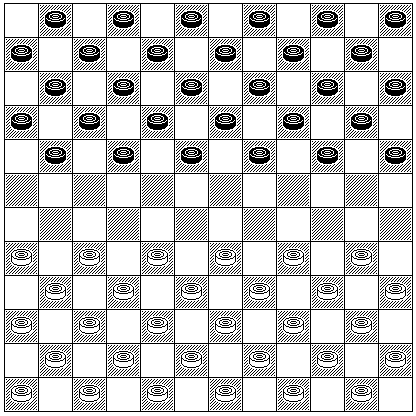
In Quebec, a game known as Canadian Checkers (although most of Canada plays the same game of Checkers as the United States and Britain) is played on a 12 by 12 board; like Continental Checkers, it also follows the same rules as German Checkers. The form of Checkers played in Sri Lanka also uses a 12 by 12 board, but it is unclear if its rules match those of Canadian Checkers.
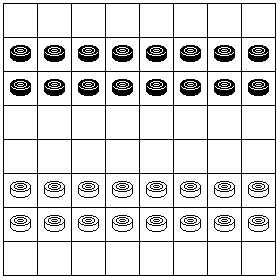
In Turkish Checkers, the pieces move and jump orthogonally, and not diagonally; that in itself simply produces the same game on an enlarged board of a different shape. But because the move is orthogonal, men may move forwards or sideways, thus having three directions of motion. Kings move as Rooks do in Chess as well as making captures by the long jump; after each step in a multiple jump, the piece captured is immediately removed from the board. A player that has at least one king wins if the other player is left with only a single man, in addition to the normal victory conditions for Checkers of eliminating or immobilizing the other side.
While Kings capture by the long jump, as in Polish Checkers, men only capture by moving two squares orthogonally, jumping over an orthogonally adjacent piece, as in conventional English Checkers except for the move being orthogonal. However, not only is capture compulsory, but the larger number of pieces must be taken as well.
Thus, the game most closely resembles Spanish Checkers, except for the ability of Kings to move more than one space in addition to having the long jump, and there is no restriction on men being able to capture kings.
An unusual variant of Checkers not found in the standard books on games is known as Armenian Checkers, which is identical to Turkish Checkers except that pieces can also move, but not capture, diagonally, men diagonally forwards, and kings in any diagonal direction.
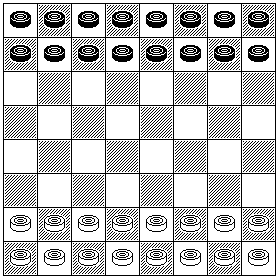
Another unusual variant of Checkers which I first heard about from R. Wayne Schmittberger's New Rules for Classic Games, and which also combines orthogonal and diagonal motion, is Gothic Checkers. In this game, men may only move diagonally forwards, and kings may only move diagonally, but capturing jumps may be made either diagonally or orthogonally, thus the combination of orthogonal and diagonal moves is exactly the reverse of that in Armenian Checkers. A man may capture forwards or sideways, a king in any orthogonal direction.
An account on the Web notes that it is compulsory not only to capture, but to capture the greater number; the rule is not given in Schmittberger's book. As this is one of the oldest known versions of Checkers, I would have assumed it to be a Jeu Plaisant without compulsory capture.
Unlike the board for Turkish Checkers, this board is shown checkered, since pieces only move diagonally, and, since jumps involve a piece moving exactly two squares for each jump, even when they are orthogonal, a piece always stays on the same color of square. That each side has two disjoint groups of pieces is an unusual characteristic of this game.